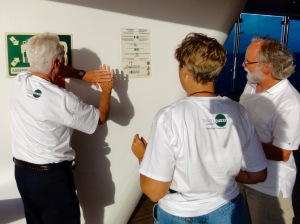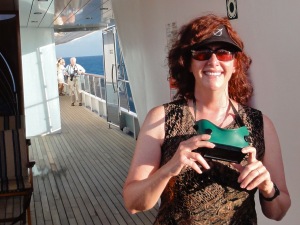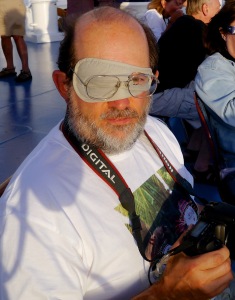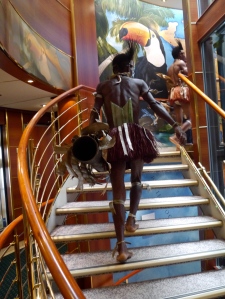Follow this link to hear my very excited and hopeful (and in retrospect, sad) RNZ interview with First Up host Lydia Batham, recorded at sea on the M/S Paul Gauguin after leaving Pitcairn Island.
Tag Archives: Cruise
Cruise to Totality on the M/S Paul Gauguin
 On Wednesday June 26 I boarded the M/S Paul Gauguin for the TravelQuest “South Pacific Cruise to Totality”.
On Wednesday June 26 I boarded the M/S Paul Gauguin for the TravelQuest “South Pacific Cruise to Totality”.
The Paul Gauguin is no stranger to eclipse chasing; she has been guided successfully into the umbra in the South Pacific four times before. Captain Toni Mirkovic from Croatia and the trip organizers were cautiously optimistic about our chances of seeing the corona, though we will be cruising straight into some dodgy weather. We’re facing several days at sea before our first destination, Pitcairn Island.
The ship is small—300 passengers—but there are nooks and crannies to discover, and the swell of the daily routine to settle into. La Pallette and Le Grill and the pool bar are on deck 8; L’etoile (the buffet) on 5 is on the way down the carpeted hall from nightly cocktails at the casino and piano bar. Pass the reception and guest desk to push open a heavy door and descend a tight stairwell to the dive marina on aft deck 4. La Veranda, a fancier restaurant, is near the spa and boutique on 6.
People LOVE the Paul Gauguin. My first impression was, “this tub is fusty.” The ship is now twenty, and she looks it. The brown and gold upholstery and draperies are unfrayed but dated. The staterooms are stately but feel well used by others who’ve slept there before. In contrast, the sparkling expedition ship Orion makes the Paul Gauguin look like my parents’ basement.
I met another traveler who was cruising on the Paul Gauguin for the 15th time—not a typo. I thought, What the hell? By the end of the journey I understood completely and had fallen in love with the PG, too. The ship has a coziness and a congenial personality, and she’s just the right size—big enough to offer variety yet each space feels intimate. It quickly turned into home.
Those who’ve been on a cruise know that there are too many scheduled activities and it’s impossible to attend them all: movies, lectures, games, crafts, lessons, and live music. Snacks and drinks and singalongs and partying by the pool. Something for everyone. I spent the first day or so regrouping after the week on Rapa Nui; plus, it was raining (and continued to rain off and on until we reached Bora Bora). <FORESHADOWING>
The cruise astronomy program was led by Rick Feinberg, Editor (and new owner) of Sky and Telescope magazine; and Alex Filippenko, professor of astronomy at Cal Berkeley and well known for his appearances in the documentary series The Universe. Throughout the week science lectures included “Highlights of the Southern Sky”; “How and Why Eclipses Happen” (for the virgins); “What Happened to Pluto?” and “Flying Through Pluto’s Shadow on Sofia”; “Dark Energy and the Runaway Universe”; and “Big Bang and Cosmic Inflation”, among others. The content seemed to get more and more dense the longer we were at sea. Though Filippenko and Feinberg are delightful lecturers, the subject matter quickly went over my head. The other passengers, a disproportionate number of science nerds, paid rapt attention to the presentations and packed the Grand Salon auditorium.
Rainy day activities at sea included eating and drinking. Making pandanas bracelets and eclipse-themed souvenirs with the Polynesian staff. More eating, and more drinking. I made some drawings of ship life, and a solemn sketch of cloud-shrouded Gambier Island as we passed.
When the ship neared Pitcairn Island there were tender tickets to procure and a preparation lecture to attend. Captain Toni was unsure we’d be able to set foot on land as stormy weather could prevent an approach to the dock. It’s possible that the Pitcairners could employ their longboats to shuttle us to shore, but that would require descending from the ship via a sketchy 18-foot rope ladder. We’ll know more tomorrow. The 1984 film “The Bounty” was screened as a pop refresher of the details of Christian Fletcher’s famous mutiny on the HMS Bounty. We’ll meet his direct descendants and the families of some of the other mutineers when we reach Pitcairn.
Great Barrier Reef
 Oh, the eclipse? *yawn* Just another breathtaking miracle of nature.
Oh, the eclipse? *yawn* Just another breathtaking miracle of nature.
The sky was blue and the Orion steady on eclipse day, following two grueling days on choppy seas to return to the calm waters over the Great Barrier Reef near Port Douglas.
Jay Anderson—meteorologist, astrophotographer, and co-author of the NASA eclipse bulletins with Fred Espenak—commanded a microphone and walked us through the timeline of events. Meet Jay in this video and hear his play by play (“filters off!” “shadow bands behind you!”). Jay also consulted with the captain and special reef pilot who was brought on board to guide the Orion over the Reef and ensure the best viewing area.
Thanks to his coaching I got my goggles on and off in time to witness all the phenomena. Baily’s beads were meh but we saw the best. diamond. ring. EVER. The prominence flames were higher than I’ve ever seen them too.
At third contact many beers (Corona, natch) were consumed, followed by brunch on deck and a how-was-it-for-you debriefing session in the Leda Lounge for the relieved and excited chasers. Most of them were either first time virgins—virgins no longer!—or had just racked up their 10th or 15th TSE. Me?
Six for six, and counting.
The moments on deck are captured in this 5-minute video. If you’re hoping to see the eclipsed sun itself, lower your expectations: this captures the minutes leading up to totality on deck, and before and after reactions. (Here’s a 3-minute video of totality—again, no sun, but you’ll see the sky go dark and brighten at third contact.
Above: Diamond ring photo via Snapfish, taken from the Paul Gauguin, July 10, 2010
Below:
Scenes on board the Orion, November 13, 2012.
Variety of customized gadgetry, including scope “squint” aids and fancy pinhole projection art.
TravelQuest founder and president Aram Kaprielian. (Is there a bigger smile than the one on the tour director after a cloudless TSE?)
Betel nut
 Like most island nations in the tropical Pacific, chewing betel nut is a popular pastime among the people of Papua New Guinea. The effect (I’m told) is a mild and calming buzz, akin to cigarette smoking. Like cigarettes, betel nut is addictive and not without side effects beyond the ghastly red smile: gum disease, tooth loss, and mouth cancer.
Like most island nations in the tropical Pacific, chewing betel nut is a popular pastime among the people of Papua New Guinea. The effect (I’m told) is a mild and calming buzz, akin to cigarette smoking. Like cigarettes, betel nut is addictive and not without side effects beyond the ghastly red smile: gum disease, tooth loss, and mouth cancer.
So what! Betel nut—actually, the areca seed and associated chewing paraphernalia—is widely sold on any market day in PNG. Some roughnecks on the street in Madang were happy to demonstrate the technique for enjoying “buai”: bite the nut meat a bit to, what, get it going I suppose, then spit the fibrous wad onto a betel leaf and add powdered lime (or, if you’re man enough, just pour the lime onto the inside of your lower lip). A type of mustard may be added to make it extra gross. Position the wad to the side of your mouth or under your lip; do not swallow. When spent, spit it on the ground, adding to the various clumps of ABC fibers in the gutter.
Justin, the Orion’s cultural liaison (and official tribesman by marriage) brought some on board for us to try during happy hour. After tasting it I can safely say I will remain betel-nut free.
Above: Market selection
Below: The Faces of Betel Nut
WWII history
 Aspects of the cruise would have been a challenge for Ralph: wading ashore after a cramped and bumpy Zodiac ride with twelve strangers; the terrifying blackfaced guy who jumped out of the jungle with a spear on Tufi; the crew talent show. But as a historian he would have loved the significant World War II sites and the buried and rusting remnants of tanks, aircraft and military vehicles in Rabaul, Alotau and Milne Bay.
Aspects of the cruise would have been a challenge for Ralph: wading ashore after a cramped and bumpy Zodiac ride with twelve strangers; the terrifying blackfaced guy who jumped out of the jungle with a spear on Tufi; the crew talent show. But as a historian he would have loved the significant World War II sites and the buried and rusting remnants of tanks, aircraft and military vehicles in Rabaul, Alotau and Milne Bay.
The military history in Milne Bay in Alotau is dear to Australians as the site of the Battle of Milne (or “Millin” as the locals say). Yamamoto—you’ve heard of him: Japanese Admiral? Battle of Midway? Bombed Pearl Harbor? that’s the one—spent his last night in a bunker in Rabaul where hand-scawled battle maps and notes remain on the walls down in the dark. Exposed caves and tunnels reveal Japanese cargo barges, and the steel bones of sunken ships and aircraft are still half buried in the sand.
For actual details, please read this moving article about PNG’s war history and relics.
Island artifacts
 At every island there were ample opportunities to shop for handmade artifacts and home goods: carved bowls and raku-style Bilbil pots, shell jewelry, bilum string bags, woven penis sheaths (a lovely souvenir to bring back to the men at home), and eerie masks.
At every island there were ample opportunities to shop for handmade artifacts and home goods: carved bowls and raku-style Bilbil pots, shell jewelry, bilum string bags, woven penis sheaths (a lovely souvenir to bring back to the men at home), and eerie masks.
Those who had an eye for tribal art were salivating, and at one point on Tami Island it was like a sale at Filene’s Basement—the collectors were prepared to physically fight each other over who would take home the best spirit mask from the selection lined up on display along the muddy main street.
I had yet to purchase my showpiece collectible when the mask supply ran low (and a sneaky couple bought the one I had chosen when I turned away for a few minutes to pull more Kina bills from my backpack). One of the sing-sing dancers ran to their costume shop and brought me a three-foot tall white Tago “ghost” mask with a feather headdress that was used ceremonially, not just made for tourists to buy. Look—it’s the same type pictured on our tour t-shirt.
Many items—certain turtle shell and bean beads, Kundu drums with lizard skin heads—would be disallowed by customs officials when we returned to Trinity Wharf in Cairns. The ship’s purser helped sort out the mess of souvenirs on board, and ensured that all items were brought to the deck of the ship to be soaked liberally with an anti-infestation spray.
I spent the entire last day on board scrounging bubble wrap from the Orion gift shop and wrapping my treasures for shipment home.
Above: New mask collection
Below:
Tapa cloth
Shlepping our souvenirs on the Zodiac
Shipboard treatment
The Tago mask—represents an ancestor ghost
Sing-sings
 A sing-sing is a cultural demonstration of ritual dance and kundu drumming, that, in many cases, was necessary to perform before we were allowed to set foot on the islands to ward off the evil spirits we brought with us on the ship (they got that right).
A sing-sing is a cultural demonstration of ritual dance and kundu drumming, that, in many cases, was necessary to perform before we were allowed to set foot on the islands to ward off the evil spirits we brought with us on the ship (they got that right).
Extravagant ceremonial costumes and body paint are worn, incorporating reeds, leaves, flowers, feathers, skins, and shells. Each island cultivates their own unique style and local custom for welcoming guests. This video will give you a taste.
Island hopping
 In 2012, 60,000 people descended on Cairns for the TSE. Ninety of us sailed away for awhile to visit the Papua New Guinea people in their secluded villages.
In 2012, 60,000 people descended on Cairns for the TSE. Ninety of us sailed away for awhile to visit the Papua New Guinea people in their secluded villages.
With expedition natural scientists as our guides we watched locals dig for Megapode eggs, laid in the ash leftover from the still-active Tavurvur volcano eruption.
We were led into remote Watam Village, where there’s no wifi—or roads, or phones, or electricity—by an ostentatious ceremonial dragon dance and witnessed “sing sing” cultural performances at every historic, scenic, mind-blowing location.
We were shown how to make pasty palm sago, the local staple that can baked into a pancake-like bread. We sailed through fjords (not just for Norway anymore) and boarded hand-carved outrigger canoes, paddled by willowy young girls, to get to villages deep in the jungle. We saw flying bat colonies and “yam houses” and masks of human bone. By the way, the people of Papua New Guinea stopped practicing headhunting and cannibalism, oh, gosh, months ago.
My favorite people were the lusty Kitava from the Trobriand Islands. When colonial rulers came to stop the inter-island warring in the 1800s they were aghast to see the suggestive thrusting and pointing during the ceremonial Kitavan dances. The Europeans introduced them to cricket as a means to channel their competitive fighting and ribald desires. Unfazed, the enthusiastic islanders just substituted a violent cricket rivalry—and used their vulgar dances anyway as a victory celebration to taunt the opposing teams.
The Orion also supplied sea kayak and snorkel gear, taught passengers how to use it, and ferried everyone via Zodiac boat to private coves to swim in the reefs and enjoy barbecue lunches on white sandy beaches. “Big Dave”, my new friend on board (and expert diver) taught me to snorkel on Nuratu Island. Underwater it was like an aquarium in a tropical fish store. The hardcore divers on board said it was the best snorkeling they’d ever experienced.
Life on the Orion
 It was a wedding gift of sorts. Two months after we married, Ralph sent me on my own to join another TravelQuest eclipse tour, this time on the glamorous expedition ship Orion. The dream itinerary: a private charter flight from Cairns Australia to Papua New Guinea to join the Orion for nine days—a ship small enough to carry passengers to several remote villages—and a grand finale, totality at the Great Barrier Reef.
It was a wedding gift of sorts. Two months after we married, Ralph sent me on my own to join another TravelQuest eclipse tour, this time on the glamorous expedition ship Orion. The dream itinerary: a private charter flight from Cairns Australia to Papua New Guinea to join the Orion for nine days—a ship small enough to carry passengers to several remote villages—and a grand finale, totality at the Great Barrier Reef.
The intimate Orion (90 passengers, 75 crew) came equipped with kayaks, Zodiac landing craft (many of our ports were “wet landings”), and diving and snorkeling gear. The professional expedition staff included a marine biologist, acclaimed wildlife photographer Sue Flood, a field biologist, meteorologist Jay Anderson, planetary scientist and former NASA astronaut Thomas Jones, and a cultural anthropologist—an Aussie who married into a PNG village and actually became a chief, who knew everyone and all the local customs.
Each day at sea there were workshops and lectures on the flora and fauna of PNG, space travel, photography, and a cultural briefing on the islands we would visit—all accompanied with drinks and traypass hors d’oevres. The food—three squares a day plus high tea and assorted cocktail parties—was exquisitely prepared and, like most cruises, nonstop. I was giddy like a girl asked to the prom when a note addressed to Miss Coleman in Stateroom 310 included an invitation to dine that night at the table of Captain Andrey Domanin, “Master of the Orion”.
One night after dinner the captain took a joy ride past the actively-erupting Manam volcano; red lava flowed down the side and rocks and flames shot out of the top. (As I watched from the deck, a glass of champagne in my hand, I wondered: am I asleep?)
Performers boarded the Orion in our last island port and drummed a farewell before we sailed to the Great Barrier Reef. The last days at sea were rough, literally and figuratively. Barf bags were tucked behind the rail on every deck. The ship’s doctor Doctor Chris administered shots and big blue nausea pills; Dramamine was heaped in a tasteful bowl on the reception counter.
I was one of the few unaffected and had work to do—an article on Burning Man due for Trailer Life magazine. I found an empty bar on the top floor of the ship but my laptop kept sliding off the table what with all the pitching and yawing. (Cruise ship tip: when seas are high, climb down to the level nearest the hull, where it’s calmer.) The dining room was sparsely populated with wan-looking, uncommunicative passengers. The ill-conceived cocktail of the day was banana liqueur and coconut rum—a little warm ginger ale might have been a bigger seller.
(Sound like fun anyway? Get on board for this one: the TravelQuest South Pacific Cruise to totality on the Paul Gauguin with a pre-vacay on Easter Island.)
Above: The Orion
Below:
Commemorative rubber stamps; All aboard; Lounge and meeting room; Stateroom 310; Cairns; Snorkel gear; On deck; From the Zodiak; Manam volcano; What to wear?; Dancers on board; Still waiting for the Green Flash.

































































































